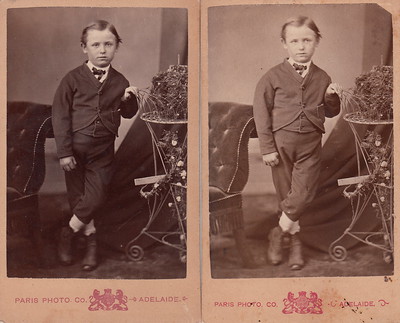Posts Tagged ‘Problem Definition’
The Importance of Moving From Telling to Asking
 Tell me what you want done, but don’t tell me how. You’ve got to leave something for me.
Tell me what you want done, but don’t tell me how. You’ve got to leave something for me.
Better yet, ask me to help you with a problem and let me solve it. I prefer asking over telling.
Better still, explain the situation and ask me what I think. We can then discuss why I see it the way I do and we can create an approach.
Even better, ask me to assess the situation and create a proposal.
Better still, ask me to assess the situation, create a project plan, and run the project.
If you come up with a solution but no definition of the problem, I will ask you to define the problem.
If you come up with a solution and a definition of the problem, I will ask you to explain why it’s the right solution.
If you come up with a problem, a solution, and an analysis that justifies the solution, I will ask why you need me.
If you know what you want to do, don’t withhold information and make me guess.
If you know what you want to do, ask me to help and I will help you with your plan.
If you know what you want to do and want to improve your plan, ask me how to make your plan better.
If you want your plan to become our plan, bring me in from the start and ask me what I think we should do.
Image credit — x1klima
There is nothing wrong with having problems.
 When you are stuck, often the problems you can describe are not the problems that are in the way.
When you are stuck, often the problems you can describe are not the problems that are in the way.
The problems you solved last time make it more difficult to see new problems this time.
The problems you know of are not the problem.
When you have no problems, you have big problems.
When you have no problem, there is no way to justify additional resources.
When you have no problem, you better finish on time.
When you’re stuck on a problem, make it worse and solve it by doing the opposite.
Problems are not bad, even though bringing them to everyone’s attention may be bad for your career.
And if talking about problems is bad for your career, you are working at the wrong company.
Until you can explain the problem in plain language, you do not understand it.
And when you do not understand a problem, you can’t solve it.
Solutions start with a problem.
Two questions to ask: Where is the problem and when does it occur?
Problems are solved with microscopes and not telescopes. Get close to the problem.
Your problem is not new. Someone has solved it in a different application, context, or product.
There are at least three ways to solve a problem: before it occurs, while it occurs, or after it occurs,
Sometimes solving a difficult problem requires the generation of an easily solvable problem. So be it.
Problems are more powerful than opportunities. Call them by their name.
Because without problems, there can be no solutions.
Image credit – Andy Morffew
What’s in the way of the newly possible?
 When “it’s impossible” it means it “cannot be done.” But maybe “impossible” means “We don’t yet know how to do it.” Or “We don’t yet know if others have done it before.”
When “it’s impossible” it means it “cannot be done.” But maybe “impossible” means “We don’t yet know how to do it.” Or “We don’t yet know if others have done it before.”
What does it take to transition from impossible to newly possible? What must change to move from the impossible to the newly possible?
Context-Specific Impossibility. When something works in one industry or application but doesn’t work in another, it’s impossible in that new context. But usually, almost all the elements of the system are possible and there are one or two elements that don’t work due to the new context. There’s an entire system that’s blocked from possibility due to the interaction between one or two system elements and an environmental element of the new context. The path to the newly possible is found in those tightly-defined interactions. Ask yourself these questions: Which system elements don’t work and what about the environment is preventing the migration to the newly possible? And let the intersection focus your work.
History-Specific Impossibility. When something didn’t work when you tried it a decade ago, it was impossible back then based on the constraints of the day. And until those old constraints are revisited, it is still considered impossible today. Even though there has been a lot of progress over the last decades, if we don’t revisit those constraints we hold onto that old declaration of impossibility. The newly possible can be realized if we search for new developments that break the old constraints. Ask yourself: Why didn’t it work a decade ago? What are the new developments that could overcome those problems? Focus your work on that overlap between the old problems and the new developments.
Emotionally-Specific Impossibility. When you believe something is impossible, it’s impossible. When you believe it’s impossible, you don’t look for solutions that might birth the newly possible. Here’s a rule: If you don’t look for solutions, you won’t find them. Ask yourself: What are the emotions that block me from believing it could be newly possible? What would I have to believe to pursue the newly possible? I think the answer is fear, but not the fear of failure. I think the fear of success is a far likelier suspect. Feel and acknowledge the emotions that block the right work and do the right work. Feel the fear and do the work.
The newly possible is closer than you think. The constraints that block the newly possible are highly localized and highly context-specific. The history that blocks the newly possible is no longer applicable, and it’s time to unlearn it. Discover the recent developments that will break the old constraints. And the emotions that block the newly possible are just that – emotions. Yes, it feels like the fear will kill you, but it only feels like that. Bring your emotions with you as you do the right work and generate the newly possible.
image credit – gfpeck
You are defined by the problems you solve.
 You can solve problems that reduce the material costs of your products.
You can solve problems that reduce the material costs of your products.
You can solve problems that reduce the number of people that work at your company.
You can solve problems that save your company money.
You can solve problems that help your customers make progress.
You can solve problems that make it easier for your customers to buy from you.
You can solve too many small problems and too few big problems.
You can solve problems that ripple profits through your whole organization.
You can solve local problems.
You can solve problems that obsolete your best products.
You can solve problems that extend and defend your existing products.
You can solve problems that spawn new businesses.
You can solve the wrong problems.
You can solve problems before their time or after it is too late.
You can solve problems that change your company or block it from change.
You are defined by the problems you solve. So, which type of problems do you solve and how do you feel about that?
Image credit – Maureen Barlin
Are you making progress?
 Just before it’s possible, it’s impossible.
Just before it’s possible, it’s impossible.
An instant before you know how to do it, you don’t.
After searching for the answer for a year, you may find it in the next instant.
If you stop searching, that’s the only way to guarantee you won’t find it.
When people say it won’t work, their opinion is valid only if nothing has changed since the last time, including the people and their approach.
If you know it won’t work, change the approach, the specification, or the scope.
If you think it won’t work, that’s another way of saying “it might work “.
If you think it might work, that’s another way of saying “it might not work”.
When there’s a difference of opinion, that’s objective evidence the work is new.
If everyone sees it the same way, you’re not trying hard enough.
When you can’t predict the project’s completion date, that’s objective evidence that the work is new.
If you know when the project will be done, the novelty has been wrestled out of the project or there was none at the start.
When you don’t start with the most challenging element of the project, you cause your company to spend a lot of money on a potentially nonviable project.
Until the novel elements of a project are demonstrated, there is no real progress.
“Jumping Backwards – Cape Verde, Sal Rei” by Espen Faugstad is licensed under CC BY 2.0.
Reducing Time To Market vs. Improving Profits
 X: We need to decrease the time to market for our new products.
X: We need to decrease the time to market for our new products.
Me: So, you want to decrease the time it takes to go from an idea to a commercialized product?
X: Yes.
Me: Okay. That’s pretty easy. Here’s my idea. Put some new stickers on the old product and relaunch it. If we change the stickers every month, we can relaunch the product every month. That will reduce the time to market to one month. The metrics will go through the roof and you’ll get promoted.
X: That won’t work. The customers will see right through that and we won’t sell more products and we won’t make more money.
Me: You never said anything about making more money. You said you wanted to reduce the time to market.
X: We want to make more money by reducing time to market.
Me: Hmm. So, you think reducing time to market is the best way to make more money?
X: Yes. Everyone knows that.
Me: Everyone? That’s a lot of people.
X: Are you going to help us make more money by reducing time to market?
Me: I won’t help you with both. If you had to choose between making more money and reducing time to market, which would you choose?
X: Making money, of course.
Me: Well, then why did you start this whole thing by asking me for help improving time to market?
X: I thought it was the best way to make more money.
Me: Can we agree that if we focus on making more money, we have a good chance of making more money?
X: Yes.
Me: Okay. Good. Do you agree we make more money when more customers buy more products from us?
X: Everyone knows that.
Me: Maybe not everyone, but let’s not split hairs because we’re on a roll here. Do you agree we make more money when customers pay more for our products?
X: Of course.
Me: There you have it. All we have to do is get more customers to buy more products and pay a higher price.
X: And you think that will work better than reducing time to market?
Me: Yes.
X: And you know how to do it?
Me: Sure do. We create new products that solve our customers’ most important problems.
X: That’s totally different than reducing time to market.
Me: Thankfully, yes. And far more profitable.
X: Will that also reduce the time to market?
Me: I thought you said you’d choose to make more money over reducing time to market. Why do you ask?
X: Well, my bonus is contingent on reducing time to market.
Me: Listen, if the previous new product development projects took two years, and you reduce the time to market to one and half years, there’s no way for you to decrease time to market by the end of the year to meet your year-end metrics and get your bonus.
X: So, the metrics for my bonus are wrong?
Me: Right.
X: What should I do?
Me: Let’s work together to launch products that solve important customer problems.
X: And what about my bonus?
Me: Let’s not worry about the bonus. Let’s worry about solving important customer problems, and the bonuses will take care of themselves.
Image credit — Quinn Dombrowski
X: Me: format stolen from @swardley. Thank you, Simon.
Problems, Learning, Business Models, and People
 If you know the right answer, you’re working on an old problem or you’re misapplying your experience.
If you know the right answer, you’re working on an old problem or you’re misapplying your experience.
If you are 100% sure how things will turn out, let someone else do it.
If there’s no uncertainty, there can be no learning.
If there’s no learning, your upstart competitors are gaining on you.
If you don’t know what to do, you’ve started the learning cycle.
If you add energy to your business model and it delivers less output, it’s time for a new business model.
If you wait until you’re sure you need a new business model, you waited too long.
Successful business models outlast their usefulness because they’ve been so profitable.
When there’s a project with a 95% chance to increase sales by 3%, there’s no place for a project with a 50% chance to increase sales by 100%.
When progress has slowed, maybe the informal networks have decided slower is faster.
If there’s something in the way, but you cannot figure out what it is, it might be you.
“A bouquet of wilting adapters” by rexhammock is licensed under CC BY-SA 2.0.
Same-But-Different, A Superpower That Can Save The Day
 If there’s one superpower to develop, it’s to learn how to assess a project and get a good feel for when it will launch.
If there’s one superpower to develop, it’s to learn how to assess a project and get a good feel for when it will launch.
When you want to know how long a project will take, ask this simple question: ‘What must the project team learn before the project can launch?” By starting with this single question, you will start the discussion that will lead you to an understanding of what hasn’t been done before and where the uncertainty is hiding. And if there’s one thing that can accelerate a project, it’s defining where the uncertainty is hiding. And knowing this doubly powerful, like a pure two-for-one, because if you know where uncertainty is, by definition, you know where it isn’t. Where the uncertainty isn’t, you can do what you did last time, and because you’ve done it before, you know how long it will take. No new tools, no new methods, no new analyses, no new machines, no new skillsets, no new anything. And for the remaining elements of the project, well, that’s where the uncertainty is hiding and that’s where you will focus on the learning needed to secure the launch.
But it can be difficult to understand the specific learning that must be done for a project to launch. One trick I like to use is the Same-But-Different method. It goes like this. Identify a project that launched (Project A) that’s most similar to the one that will launch next (Project B) and perform a subtraction of sorts. Declare that Project B (the one you want to launch) is the same as Project A (the one you already launched) but different in specific ways and then define those differences as clearly and tightly as possible. And where it’s different, that’s where the learning energy must be concentrated.
Same-But-Different sounds simplistic and trivial, but it isn’t. More than anything, it’s powerful. For the elements that are the same, you do what you did last time, which is freeing. And for the small subset if things that are different, you dig in!
Same-But-Different drives deep clarity and extreme focus, which result in blistering progress and blinding effectiveness.
And for some reason unknown to me, asking a team to define the novel elements of a project is at least fifty times more difficult than asking them how Project B is different than Project A. So, it feels good to the team when they can use Same-But-Different to quickly easily define what’s different and then point directly to the uncertainty. And once the team knows where the uncertainty is hiding, it’s no longer hiding.
And if there’s one thing a project team likes, it’s knowing where the uncertainty is hiding.
“The same, but different by the Paris Photographic Co. (c.1880)” by pellethepoet is marked with CC BY 2.0.
Problems, Solutions, and Complaints
 If you see a problem, tell someone. But, also, tell them how you’d like to improve things.
If you see a problem, tell someone. But, also, tell them how you’d like to improve things.
Once you see a problem, you have an obligation to seek a solution.
Complaining is telling someone they have a problem but stopping short of offering solutions.
To stop someone from complaining, ask them how they might make the situation better.
Problems are good when people use them as a forcing function to create new offerings.
Problems are bad when people articulate them and then go home early.
Thing is, problems aren’t good or bad. It’s our response that determines their flavor.
If it’s your problem, it can never be our solution.
Sometimes the best solution to a problem is to solve a different one.
Problem-solving is 90% problem definition and 10% getting ready to define the problem.
When people don’t look critically at the situation, there are no problems. And that’s a big problem.
Big problems require big solutions. And that’s why it’s skillful to convert big ones into smaller ones.
Solving the right problem is much more important than solving the biggest problem.
If the team thinks it’s impossible to solve the problem, redefine the problem and solve that one.
You can relabel problems as “opportunities” as long as you remember they’re still problems
When it comes to problem-solving, there is no partial credit. A problem is either solved or it isn’t.
Do you have a problem?
 If it’s your problem, fix it. If it’s not your problem, let someone else fix it.
If it’s your problem, fix it. If it’s not your problem, let someone else fix it.
If you fix someone else’s problem, you prevent the organization from fixing the root cause.
If you see a problem, say something.
If you see a problem, you have an obligation to do something, but not an obligation to fix it.
If someone tries to give you their stinky problem and you don’t accept it, it’s still theirs.
If you think the problem is a symptom of a bigger problem, fixing the small problem doesn’t fix anything.
If someone isn’t solving their problem, maybe they don’t know they have a problem.
If someone you care about has a problem, help them.
If someone you don’t care about has a problem, help them, too.
If you don’t have a problem, there can be no progress.
If you make progress, you likely solved a problem.
If you create the right problem the right way, you presuppose the right solution.
If you create the right problem in the right way, the right people will have to solve it.
If you want to create a compelling solution, shine a light on a compelling problem.
If there’s a big problem but no one wants to admit it, do the work that makes it look like the car crash it is.
If you shine a light on a big problem, the owner of the problem won’t like it.
If you shine a light on a big problem, make sure you’re in a position to help the problem owner.
If you’re not willing to contribute to solving the problem, you have no right to shine a light on it.
If you can’t solve the problem, it’s because you’ve defined it poorly.
Problem definition is problem-solving.
If you don’t have a problem, there’s no problem.
And if there’s no problem, there can be no solution. And that’s a big problem.
If you don’t have a problem, how can you have a solution?
If you want to create the right problem, create one that tugs on the ego.
If you want to shine a light on an ego-threatening problem, make it as compelling as a car crash – skid marks and all.
If shining a light on a problem will make someone look bad, give them an opportunity to own it, and then turn on the lights.
If shining a light on a problem will make someone look bad, so be it.
If it’s not your problem, keep your hands in your pockets or it will become your problem.
But no one can give you their problem without your consent.
If you’re damned if you do and damned if you don’t, the problem at hand isn’t your biggest problem.
If you see a problem but it’s not yours to fix, you’re not obliged to fix it, but you are obliged to shine a light on it.
When it comes to problems, when you see something, say something.
But, if shining a light on a big problem is a problem, well, you have a bigger problem.
“No Problem!” by Andy Morffew is licensed under CC BY 2.0
It’s time to start starting.
 What do we do next? I don’t know
What do we do next? I don’t know
What has been done before?
What does it do now?
What does it want to do next?
If it does that, who cares?
Why should we do it? I don’t know.
Will it increase the top line? If not, do something else.
Will it increase the bottom line? If so, let someone else do it.
What’s the business objective?
Who will buy it? I don’t know.
How will you find out?
What does it look like when you know they’ll buy it?
Why do you think it’s okay to do the work before you know they’ll buy it?
What problem must be solved? I don’t know.
How will you define the problem?
Why do you think it’s okay to solve the problem before defining it?
Why do you insist on solving the wrong problem? Don’t you know that ready, fire, aim is bad for your career?
Where’s the functional coupling? When will you learn about Axiomatic Design?
Where is the problem? Between which two system elements?
When does the problem happen? Before what? During what? After what?
Will you separate in time or space?
When will you learn about TRIZ?
Who wants you to do it? I don’t know.
How will you find out?
When will you read all the operating plans?
Why do you think it’s okay to start the work before knowing this?
Who doesn’t want you to do it? I don’t know.
How will you find out?
Who looks bad if this works?
Who is threatened by the work?
Why do you think it’s okay to start the work before knowing this?
What does it look like when it’s done? I don’t know.
Why do you think it’s okay to start the work before knowing this?
What do you need to be successful? I don’t know.
Why do you think it’s okay to start the work before knowing this?
Starting is essential, but getting ready to start is even more so.
Image credit — Jon Marshall
 Mike Shipulski
Mike Shipulski